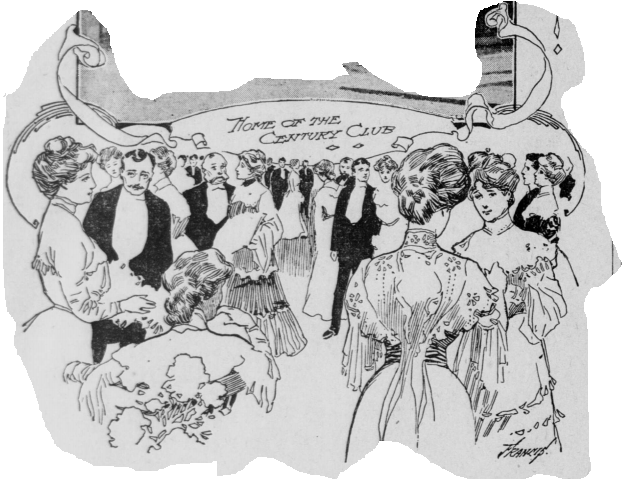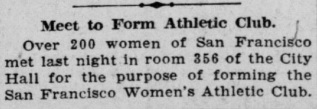The Women’s Club Movement and its Historic Buildings
If you grew up in the United States, it is likely that your city or town included a building that housed a women’s club. And it is also likely it was built during the first two decades of the 20th century. In most cases, these structures were residential in style, but in some of the larger cities, including the Women’s Athletic Clubs of Chicago and San Francisco, they were prominently placed in the heart of the cities’ business districts and purposely designed to be grand in scale.
The Beginning of the Women’s Club Movement
According to historian Michael Corbett, author of the Woman’s Athletic Club of San Francisco’s nomination to the National Register of Historic Places, the women’s movement was begun in the 1860s and 1870s by women who had been active in social causes such as better education, women’s rights, human rights, and emancipation. In her book, The History of the Woman’s Movement in America (1898), Jane C. Croly predicted, “When the history of the nineteenth century comes to be written, women will appear as organizers and leaders of great organized movements among their own sex for the first time in history.”
The strength of the movement continued to grow into the 1930s. Eventually, there were thousands of women’s clubs and millions of members. In their 1942 Handbook for Clubwomen, Irene and Winthrop Munro put the figure at well over three million.

In 1925, Alice Ames Winter wrote The Business of Being a Club Woman in which she shared her thoughts about the impetus for the women’s club movement. “Clubs come into being because from a group something comes into our lives greater than anyone can get alone, that something that blends companionship, friendship, the wisdom that comes from many minds rubbing against each other, the inspiration that springs from such contact of mind with mind, and the efficiency that results from the combined effort.”
She goes on: “We want communities that are extensions of the home, where we shall be friends with each other, we people of all races and creeds” working toward such things as good schools, public health, recreation, and beauty. “There is no community so small that it cannot realize these ambitions. And when you put them in your hometown, you have helped make your nation one hundred percent American.”
The first woman’s club in the United States is generally agreed to have been the New England Woman’s Club in Boston, founded in 1868 (although the Sorosis Club of New York was founded the same year) by Caroline Severance, Harriet Hanson Robinson and Julia Ward Howe, all suffragists. Severance went on to found the Friday Morning Club of Los Angeles and has been given the title of “Mother of Clubs” by many biographers. The purpose of the New England Woman’s Club was to “provide a suitable place of meeting in Boston for the convenience of its members, and to promote social enjoyment and general improvement.” Activities included frequent lectures by both members and invited speakers. San Francisco’s Century Club, for example, required its members to attend study groups and present papers. It also allowed itself to engage in “reform” by a majority vote, under which provision it provided the leadership and funding for the 1888 school board campaign in which three Club members were candidates.

Retrieved from chroniclingamerica.loc.gov
Women’s Clubhouses
In the 1890s, Club women began building their own buildings. An article in Harper’s Bazaar reported 70 women’s clubhouses in the U.S., including 11 in California, according to author Gayle Gullett.
Gullett’s book Becoming Citizens: The Emergence and Development of the California Women’s Movement, 1880-1911, explains, “The women’s clubhouses provided a protected interior social space that facilitated the objectives of its members, whether study, reform, sociability, or all three. Clubhouses also represented much more. . . Club members proudly emphasized that the clubhouses demonstrated women’s business acumen; the cost of the buildings underlined that they exercised their financial skills in an environment of wealth. The buildings were expensive because the women used them to make an aesthetic statement – the buildings were what would be expected of ladies of culture – and because they provided
spaces for libraries, auditoriums, meeting rooms, and banquet halls, places of women’s work.”
Women’s Clubs in San Francisco

Women’s clubs began to appear in San Francisco in 1885. The Century Club (1888), The Town and Country Club (1893), the California Club (1897), the Francisca Club (1903) and the Woman’s Athletic Club (1915 – now the Metropolitan Club) remain today with their own buildings. The last major women’s club to be built before World War II was the San Francisco Women’s Building (1927 – now the Marines’ Memorial Club, (609 Sutter Street.) When it opened, the latter was described as “a civic center for women” and was not so much a single club as a center for clubs and clubwomen (Corbett.)
These San Francisco clubs had various purposes. The Century Club (located at 1355 Franklin Street) had the “vision of uniting professional and upper-class women and training them to serve as patrician leaders in community betterment,” according to Gayle Gullett (Becoming Citizens: The Emergence and Development of California’ Women’s Movement.) The Town and Country Club (218 Stockton Street) began as the Woman’s Book Club but was predominantly a social club. The Francisca Club (595 Sutter) was also primarily a social club. The California Club (1750 Clay Street) was an active suffragist organization and featured a Civic Department, Social Science Department, Educational Department, and the Outdoor Art League.
Women’s Clubs Achieve Historic Designation
The Woman’s Athletic Club of Chicago was the model and inspiration for the Woman’s Athletic Club of San Francisco. Both offered a large range of athletic and sports activities common to the men’s athletic clubs of the day. The Chicago club was named a local landmark in 1991.
Over the years, many of women’s club buildings have been listed in the National Register of Historic Places. About 120 NRHP-listed women’s club buildings are included on a Wikipedia list from Arizona to Wyoming to New York. If you are interested in looking up a specific NRHP-listed building, here is the link: https://en.wikipedia.org/wiki/List_of_women%27s_club_buildings
With the growing recognition of the importance of the women’s club movement, a number of architecturally and socially significant women’s club buildings are benefitting from the creation of charitable foundations whose missions are to preserve for public benefit these worthy historic resources. The 640 Heritage Preservation Foundation is one of these.